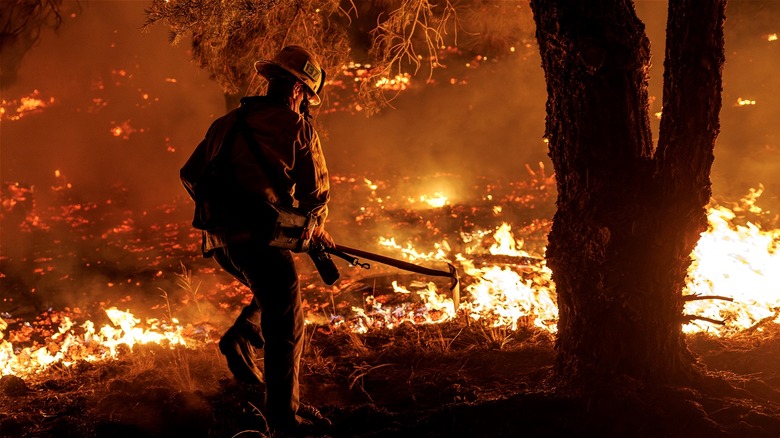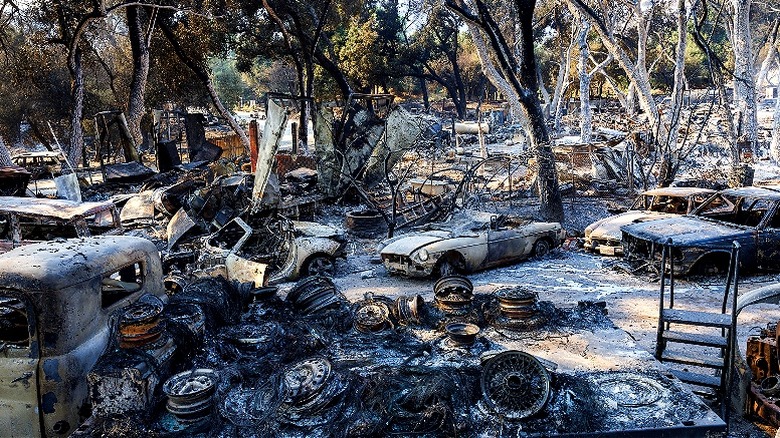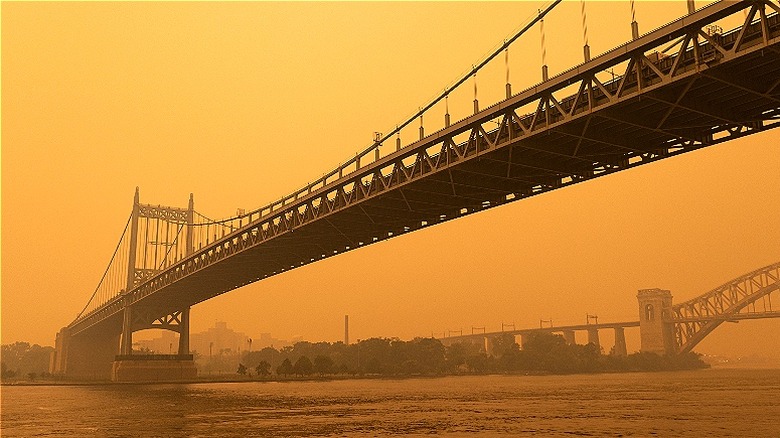The Cost Of Battling Wildfires Is More Than You Think
As climate change-fueled weather disasters like wildfires, hurricanes, and tornadoes, continue to break records, more and more Americans are finding themselves facing impossible situations. Not only have people faced extensive damage to or even the loss of their homes and cars, but natural disasters have also made it harder than ever for consumers to get things like homeowners insurance (while simultaneously driving up prices on things like car insurance). To make matters worse, the costs associated with the prevention, suppression, damage, and clean-up of these disasters is in the trillions of dollars — $2.78 trillion since 1980, to be exact, according to the National Oceanic and Atmospheric Administration's National Centers for Environmental Information.
While the increase in weather and climate disasters can be felt across most of the United States, wildfires, in particular, have experienced a significant boom in recent years. Wildfires haven't only grown more common, but they've also grown larger with the average annual acres burned steadily increasing since 1950. Alongside the increase in fires is the increase in costs to put those fires out. According to the budgets of both the U.S. Department of Agriculture's Forest Service and the U.S. Department of the Interior, fire suppression has cost an average of $2.9 billion per year over the last decade. Keep in mind this total doesn't include the damage or clean up associated with a wildfire, only the costs required to extinguish one.
How wildfires affect consumers
Beyond the immediate danger of facing a wildfire in your area, even being in certain fire-prone geographic regions could cost you. In fact, a significant consideration for anyone living in a state with a higher risk of wildfires is how it could affect your ability to purchase, finance, or even insure your home. In fact, there are some places in the country where it might be better to avoid buying a home altogether given the higher risk of climate-related weather disasters. Increasingly, insurance companies are dropping policies and leaving entire states in order to avoid having to pay out in the event of any natural disasters. This can make it impossible to financially protect your home and belongings in the event of a disaster.
Things can be even worse for renters living in wildfire-prone areas, where there are few financial protections in the event of a fire. According to a working paper from the Federal Reserve Bank of Philadelphia, published in January 2024, financial distress rates rose for renters in burn zones and were especially detrimental for renters with lower credit scores. Not to mention, homes in burn zones are subject to increased levels of wildfire air pollution, which can carry significant health risks. Plus, residents in wildfire areas could also face what are known as indirect losses; such losses happen as a direct result of an event such as a wildfire but might not be as obvious as, say, direct fire damage to a home. These can include losses from power shut-offs, business closures, travel cancellations, and supply chain disruptions, which can all require extended periods of time to get back to "normal."
Consequences of climate change
While it can be easy to focus solely on areas directly affected by wildfires, the consequences of increasing weather events can be far more widespread than any single place. On a much larger scale, damaging emissions from large-scale fire events (such as the 2019-2020 Australia fire or the 2023 Canadian fires) can actually trigger far-reaching weather changes in other parts of the world.
For instance, a 2023 study in the journal Science Advances found that the 2019-2020 Australian wildfires contributed to a rare three-year-long La Niña weather event that led to wetter and colder conditions throughout the Pacific Northwest and Northern Plains regions of the U.S., as well as to drier conditions in southern regions from 2020-2023. This means that, as a consumer, even if you choose to live in a place that's not considered a wildfire-prone area, you could still end up with fallout from wildfires that occur in other places.
Wildfires can also greatly contribute to our worsening climate crisis (not to mention how natural disasters can affect the stock market). This is due in large part to the fact that trees release carbon dioxide as they burn, speeding up existing atmospheric concerns. Plus, while trees would normally be able to recapture much of this carbon (forests absorb a net 7.6 billion metric tonnes of carbon dioxide per year, according to research published in Nature Climate Change), as more forests burn, there are fewer trees to pick up the added emissions. This can lead to increased levels of climate change-related weather events across the country.


